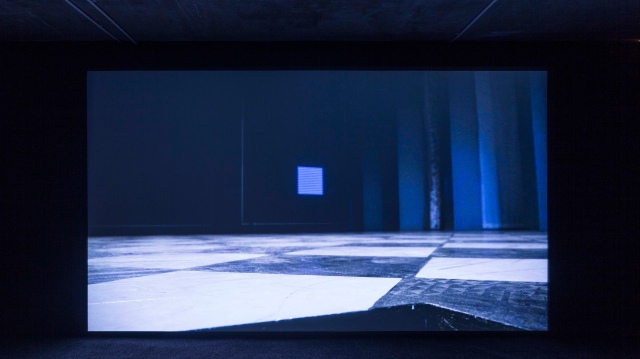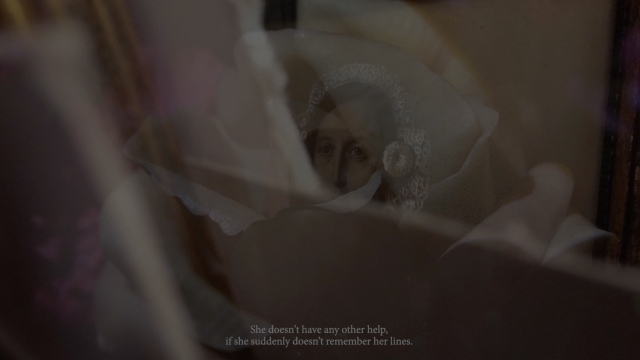The Invisible Voice, an intriguing video installation by UK-trained Danish artist Julie Born Schwartz, was inspired by conversations with theatre prompters and a life-long fascination with the theatre form. The installation was shown recently at London’s Union Pacific Gallery.
A spotlight breaks the darkness and glides across an empty auditorium. A peak across a silent stage, a fragment of the front curtain. The rustle of a manuscript, a glimpse of costumes and props.
The eye of the camera moves through fleeting, fading, half obscured images of a seemingly secret world where people are hinted at but never seen. Only a solitary pair of hands glide across lines of dialogue on a sheet of script. A voice floats in from the left, another from the right, telling stories. A warm, excited laughter hangs in the air then dissolves while the screen goes briefly dark. We watch, we listen, we wait.
It is hard to tear yourself away from »The Invisible Voice«, the aptly named video installation by Julie Born Schwartz. The Danish artist, who studied at both Goldsmiths University and the Royal Academy of Arts in London, has often found inspiration in the world of theatre which has fascinated her since an early childhood trip to see a Strindberg play. Henrik Ibsen is another playwright who has inspired her since she was quite young.
And here she returns to it again, taking her cue – quite literally – from conversations with theatre prompters which we hear in fragments across the soundtrack of the film.
Theatre prompters are that increasingly rare breed of people whose job it is to sit near the stage, hidden away from the audience, and whisper cues to actors – or opera singers – should they forget their lines. It is in the nature of these prompters’ work to be invisible, and to be heard only by the actors, so that the illusion for the audience remains unbroken.

Video still courtesy of Julie Born Schwartz
The film itself never breaks the illusion either. It is almost as if we are intruding on a secret world, and there is an aloofness in the film’s mix of fleeting images and sounds.
»Magic?« asks one voice, while the screen goes dark. »Magic!« replies another. And a magic worm appears as if floating freely in the air, the thread by which it hangs seemingly invisible. It is the only image in the film which did not come from the world of theatre
Julie Born Schwartz came across the worm by chance while walking through the forest. And it is often this kind of randomness that informs her work, in the sense that it tends to spring from random meetings with people and random impressions of places.
»Fly Me To The Moon« (2011), for instance, was inspired by a man she often saw while running in the local park; he turned out to be a retired actor and opera singer and is heard in the film talking about his life, including the loss of his wife, over theatre stills, stage footage and images of cosmic constellations.
The theatrical theme returns again, albeit in a more primal sense, in »Love Has No Reason« (2014), which came out of Julie Born Schwarz’ experiences on an acting workshop in New York run by Danish director Per Brahe. He talks in the film about freeing expression using masks, and then removing the masks.
»Magnetic Levitation« (2010), a meditation on science and religion, sprang from coming across a group of people who believe in capturing and storing human energy. This work explores things that science cannot explain, another subject that has long fascinated Julie Born Schwarz, who grew up with a scientist father.
That theme appears again in »I Had an Expectation That It Would Fade« (2013), which came out of conversations with people who had lost limbs but continued to feel fantom pain in their missing limbs.
Her films seem to carry an echo of fleeting impressions, and she likes to play with the narrative structure. But there is nothing random about the work itself; she may take up to a year or more to work on a specific piece and will often go back for repeated interviews with the people who inspire her work.
With »The Invisible Voice« she had her own insights to draw on, as she once worked briefly as a prompter herself, but she also spent time travelling round to old Danish theatres in search of prompter boxes that were still intact, and repeatedly went back to her interviewees.

Video still courtesy of Julie Born Schwartz
For this film, in keeping with its theme of people who, in their work, may be heard but not seen, she worked on the audio track first and then put the visual elements together, which was a new approach for her. But she never goes into a project with a preconceived notion of how it is going to be, and she likes that challenge of exploring, she says during an interview at the Union Pacific Gallery in Aldgate, East London.
»It’s a little bit how my philosophy in life is, and how I am with the project or the process. When I start something, there’s a curiosity and maybe I am meeting with someone. And it is hard for me to say: this is going to be a film or a sculpture or… I have to see what happens in the meeting that makes it evolve from there. That is why it ends up taking different shapes and forms. But quite often it is some kind of installation and maybe also a bit theatrical way of doing things, like a room where you come in and see different elements.«
At Union Pacific Gallery, where »The Invisible Voice« was shown from 22 January to 29 February this year, the installation started in a room bathed in blue, with just music playing (by Danish theatre composer Louise Alenius), two warmly glowing chandeliers hanging from the otherwise industrial-looking ceiling and a few antique theatre books placed near a staircase leading down to a dark room where the film itself ran on a continuous loop.
While Julie Born Schwartz tends to work with video, still photography and objects, she feels very strongly about installation as a form of showing her work, because of the experience that the viewer gets in seeing it live.
For the same reason, she puts only still photographs of her installations and films on her website, and not the actual films. The exception is »One More Kiss«, a video project made during a year spent in Beijing, as this was specifically commissioned to be shown online.
Her installations will also vary depending on the space that she has to work with. »I like to sense what space I am in and make the installation depend on that space. Maybe again going back to the theatre and the live experience of the story. You are in there when it happens. Maybe the film is always looping. I like the loop somehow and stories that you can go and take fragments of, and it should still do something. The story takes shape in another way than if you sit and see it from a clear narrative structure. There is more open room to explore the story.«
The installation will now go to Germany, where Julie Born Schwartz hopes to show it in a public space that will also allow the film itself to be visible from the street.
And perhaps most fittingly: It will be next to a theatre.
Watch a video interview with Julie Born Schwartz at the Royal Academy of Arts website
Read more about the Theatre Museum in Copenhagen
The Theatre Museum also has a piece about The Invisible Voice (in Danish) here
